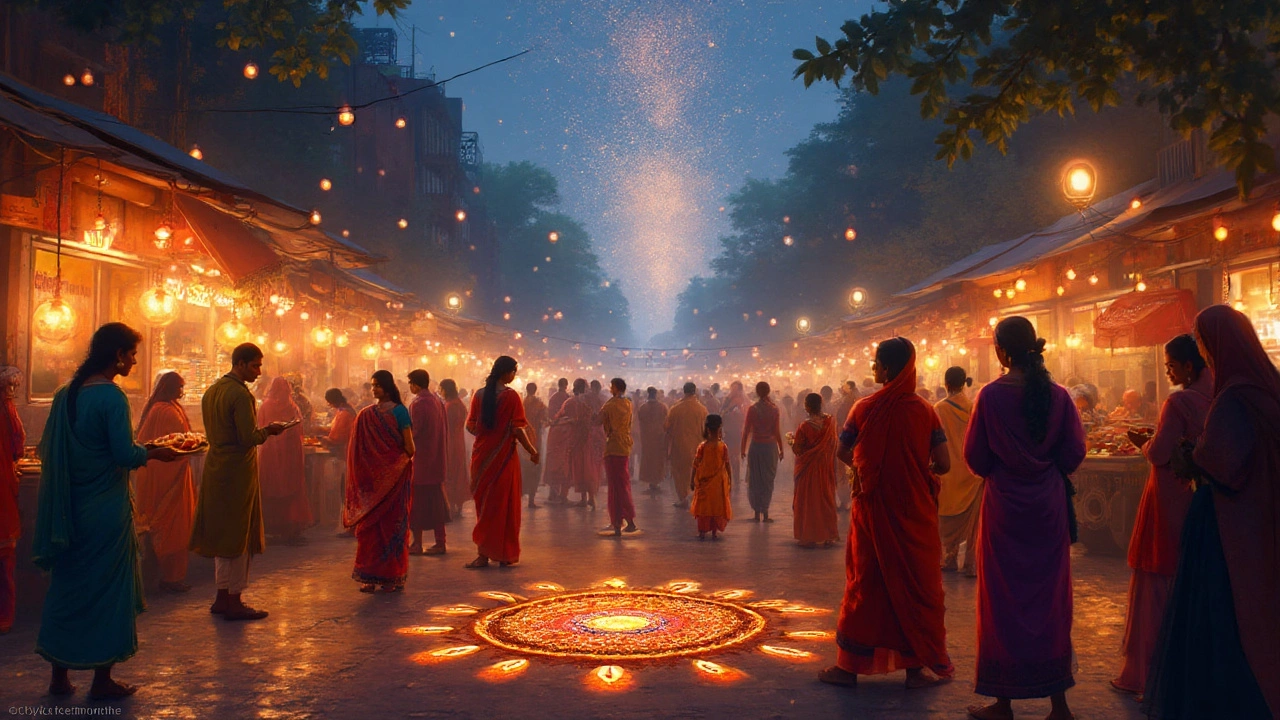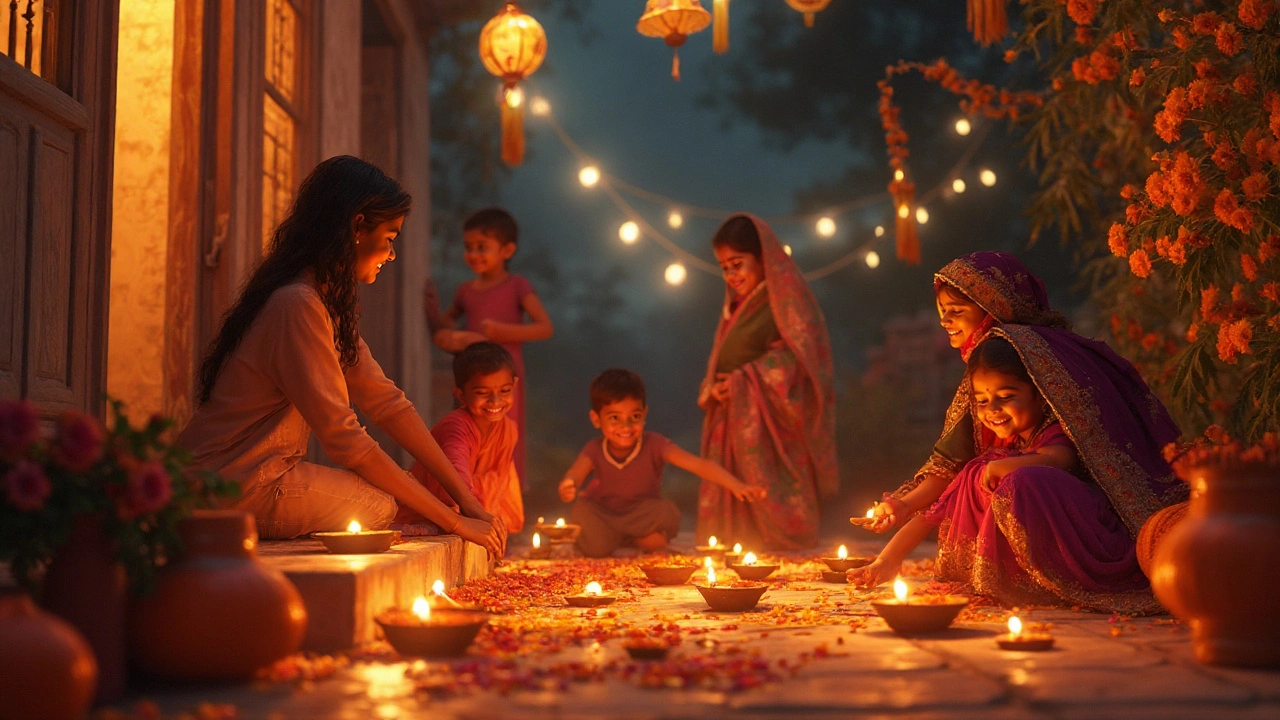You can feel Diwali in the air weeks before it even starts: the soft glow of fairy lights, the clang of coins in bustling markets, and that unmistakable sweet smell of cardamom and ghee wafting from kitchens. There’s real magic to the way the country transforms — cities come alive, villages glow, and people’s faces seem to light up with anticipation. If you’ve ever asked someone in India, “What’s your favorite festival?” most don’t even need to think before they say Diwali. It stands out not just for its high-spirited celebrations but for the way it brings people together—no matter your background or beliefs. There are hundreds of festivals across India, but Diwali’s got that extra something. Let’s peel back the layers and see what makes it the heartbeat of Indian festivities.
The Origins of Diwali: Myths, Legends, and Why It’s Celebrated
The roots of Diwali twist deep into ancient Indian history, and the stories aren’t just one-size-fits-all. Most people think of Diwali as the day Lord Rama returned to his kingdom Ayodhya after 14 years in exile, having defeated the demon king Ravana. The city lit up with rows of clay lamps (diyas) to welcome him home. But it doesn’t stop there. Across India, different communities have their own legends. In Bengal, they worship Goddess Kali; in parts of the north, it’s about Lord Krishna’s victory over Narakasura. Down south, some folks remember the day Lord Vishnu sent King Bali to the netherworld.
How old is this celebration? We’re talking thousands of years—some records even place mentions of Deepavali (an older name for Diwali) in Sanskrit texts dated over 2,500 years ago. And this isn’t just a Hindu affair. Jain families celebrate Diwali as the day Lord Mahavira found enlightenment. Sikhs mark the release of Guru Hargobind from imprisonment and refer to it as Bandi Chhor Divas. For many business communities, the festival marks the start of the financial new year — a day when old books are closed and new ones started, blessed with prayers for good fortune. The point is, whether you’re in Delhi, Chennai, Kolkata, Ahmedabad, or even overseas, Diwali brings a story everyone can connect with, layered with local color and sentiment.
Ever wondered about the term ‘Festival of Lights’? The word ‘Diwali’ itself comes from the Sanskrit ‘Deepavali’, meaning ‘a row of lights’. Streets, houses, and temples all get the luminous treatment, symbolizing the triumph of light over darkness, good over evil, and knowledge over ignorance. Recent studies estimate that during Diwali, Indians use around 2 billion oil lamps and candles in one night. Take a second to imagine every home in your city lighting a slick, bright lamp at the same moment. It’s a real goosebumps moment.
Want a fun fact? In 2016, the city of Ayodhya set a Guinness World Record for lighting over 300,000 diyas on the banks of the river Saryu in a single evening. And it’s not just about religious symbolism. These legends and traditions have real impact, weaving meaning into everyday rituals, conversations, and fireside tales that get passed from generation to generation.
How Diwali Is Celebrated: The Rituals, Food, and Family Bonds
Ever tried waking up before dawn, only to be gently dragged out of bed by family for a pre-sunrise oil bath? It happens in a lot of Indian households on Diwali morning. Trust me, it’s not something you forget, and it sets the tone for the rest of the day—fresh, hopeful, ready for new beginnings. Preparations start well in advance, with homes getting a complete scrub down. The belief isn’t just in cleaning physical grime but also clearing out any bad vibes to make space for positivity and good luck. In markets from Mumbai to Madurai, families hunt for the perfect new clothes, and you’ll see a mix of modern styles and traditional Indian wear, all shimmering with bling.
But let’s talk about the Diwali spread. If there’s an award for the world’s tastiest festival foods, Diwali wins hands down. Sweet shops double their staff and work round the clock, churning out laddoos, barfis, jalebis, and gulab jamun by the kilo. There’s always a battle over the last piece of kaju katli in my house. Savouries like chakli, samosas, and mathri pile up, and neighbors happily swap goodies so you end up with wild assortments of treats. Tip: If you ever get invited to a Diwali gathering, always bring a box of sweets—no one will ever say no to kaju katli or soan papdi (just expect some inside jokes about re-gifting).
The rituals evolve as the evening rolls in. Temples overflow with devotees offering prayers (pujas), and in most homes, the Laxmi Puja steals the show. People lay out their pooja thalis with incense, flowers, fruits, and shimmering coins. The idea is to welcome Goddess Laxmi, who’s all about bringing wealth and prosperity. Children park themselves at the door, holding sparklers or diyas, itching to start the real fun—firecrackers. It’s loud, yes, but the excitement is contagious. In recent years, with everyone more aware of pollution, many families choose light shows, lamps, and rangoli (colorful art made with powder, rice, or flower petals) instead of loud crackers. Kids and parents get super competitive about who’s made the best rangoli, and social media gets flooded with dazzling designs.
Above all, Diwali is a time for togetherness. Grandparents narrate stories, cousins team up for games, and that sense of belonging feels especially powerful. Even people living far from home—students, those abroad—go out of their way to connect with family via video calls, sharing virtual pujas and even eating together over a screen (I tried this with my mate from Delhi last year—no replacement for real hugs, but technology does help bridge the gap!).

Light, Color, and Commerce: Diwali’s Impact on Indian Life
Step into any big Indian market a few days before Diwali, and you’ll get swept up in the energy. Streets are jam-packed with shoppers looking for everything from sparkly sarees to the latest gadgets. According to India’s Retailers Association, Diwali shopping routinely pushes retail sales by more than 40% compared to other months. It’s the time when families go all out, buying appliances, gold jewelry, and homemade gifts to share with loved ones and employees.
| Item | Estimated Sales Growth During Diwali (%) |
|---|---|
| Consumer electronics | 50 |
| Jewelry | 35 |
| Sweets & snacks | 60 |
| Clothing | 45 |
| Home décor | 55 |
Merchants plan their entire business year around the festival. It’s also bonanza time for artisans: candle makers, potters, sweet-makers, flower sellers—everyone sees a surge in orders. Small-scale families making hand-painted diyas sometimes clock in 18-hour days just before the festival, knowing these special weeks could secure their year.
And while you’ll see massive sales and pop-up markets in places like Mumbai’s Crawford Market or Delhi’s Chandni Chowk, remote villages get just as festive. In the Tamil countryside, you might spot lines of tiny oil lamps and burst after burst of flower-petal rangolis leading up to doorways, creating glowing, welcoming paths for neighbors and guests well into the night.
The festival isn’t just about shopping. Schools, offices, and even public parks get decked out for the occasion. People give each other small tokens—sometimes chocolates or sweet boxes, sometimes as simple as a single marigold flower. Offices often organize Diwali parties. There’s an almost electric sense of goodwill; even strangers wish each other well on the street. And in big Indian cities, relatives you haven’t seen in years show up at your door with sweets, just because it’s Diwali. You always end up meeting someone you weren’t expecting.
This explosion of color and commerce turns the festival into something bigger than just a religious event—it feels like a national holiday that absorbs and reflects all the diversity and vibrancy of Indian culture. Even Indian expats recreate this energy in cities around the world. London gets its own version with fireworks on Southall Broadway, and you see similar festivities in New York, Sydney, and Dubai. Everything is turned up one notch, from light displays to food feasts.
Modern Diwali: Sustainability, Inclusiveness, and the Spirit of Giving
The India of today is different from the one where Diwali began. City skylines replace ancient kingdom walls, WhatsApp greetings fly out at midnight, and kids swap traditional sparklers for eco-friendly lanterns. But the festival keeps adapting, holding onto its core while changing with the times. Sustainability is taking the spotlight. Young Indians across cities push for less plastic and fewer firecrackers. Many apartment blocks now run “green” Diwali campaigns—neighbors gather to make their own compostable diyas or switch to LED fairylights. Some schools host swap fairs where old decorations are traded, up-cycled, or repainted instead of tossed.
Since air quality takes a dip from crackers, urban families have started choosing laser light shows or organizing community fireworks displays that last a few minutes, not all night. In my London neighborhood, the Indian community lights up the park with hundreds of diyas and holds a charity fundraiser, making a real impact.
Inclusiveness is just as important. The beauty of Diwali is how it invites everyone in. Muslim, Christian, Sikh, Hindu—people celebrate together in workplaces and neighborhoods. College campuses organize Diwali nights, complete with rangoli competitions and Bollywood dance-offs. In fact, a 2024 poll revealed that over 70% of non-Hindu residents in Indian metro cities join at least one Diwali puja, potluck, or party each year. That blending is everywhere, right in the sweets exchanged, the greetings shared, or the neighbors who walk in, diya in hand, just to light it in someone else’s doorway.
And let’s talk about giving back. Charity drives spike during Diwali. Many households set aside part of their festival budget for donations, whether it’s food, clothes, or money to local shelters. Large businesses run CSR programs that provide meals or scholarships. Even school kids are encouraged to share a part of their Diwali stash with those in need. This spirit of sharing stands out—people want everyone around them to feel the glow, not just in their homes but in their communities.
So if you’ve never experienced Diwali, or you’re curious to see what all the fuss is about, don’t wait for an invitation. Grab a box of sweets, knock on a neighbor’s door, and become part of the festival. Whether you’re weaving marigold garlands with your gran, swapping rangoli hacks with a classmate, or just soaking up the energy on a bustling street, you’ll find yourself drawn in. Diwali is more than an event; it’s a feeling that lasts long after the last lamp is blown out and the final mithai disappears. That’s what makes it India’s most beloved festival—and honestly, I’d say, one of the world’s too.
